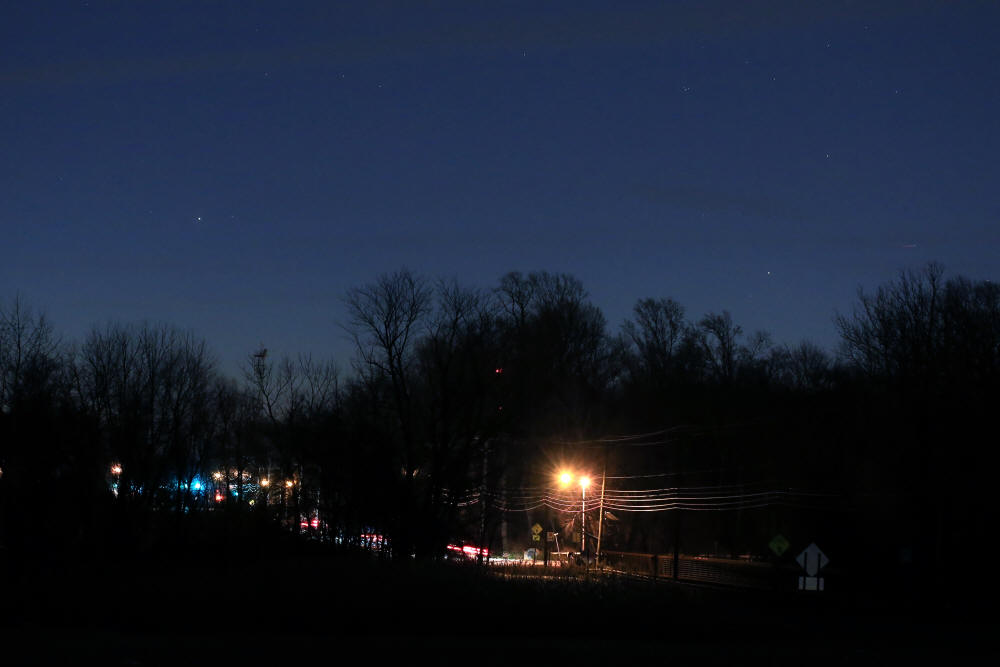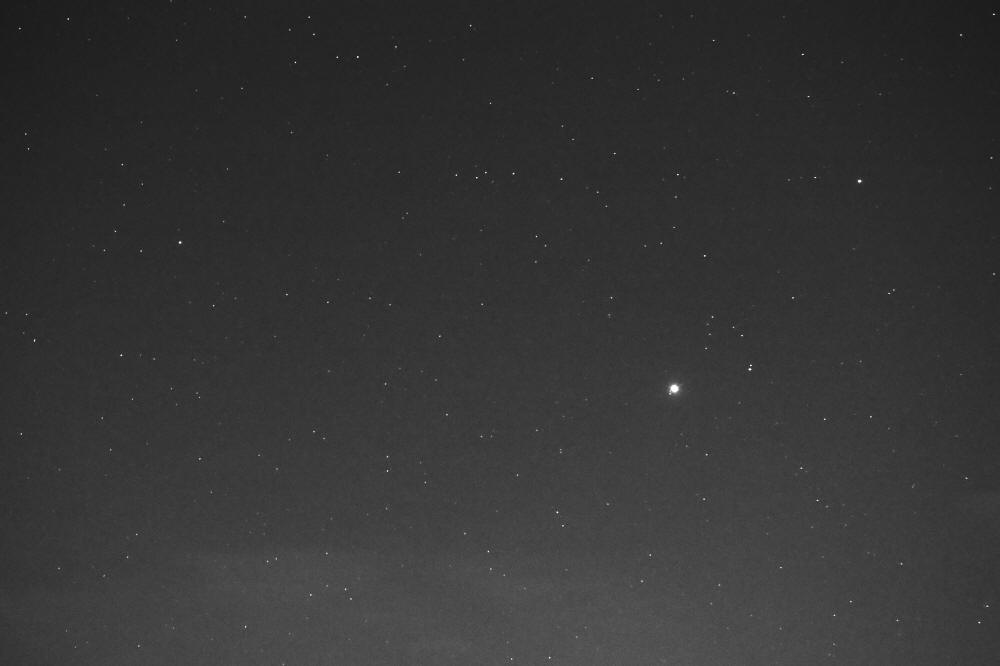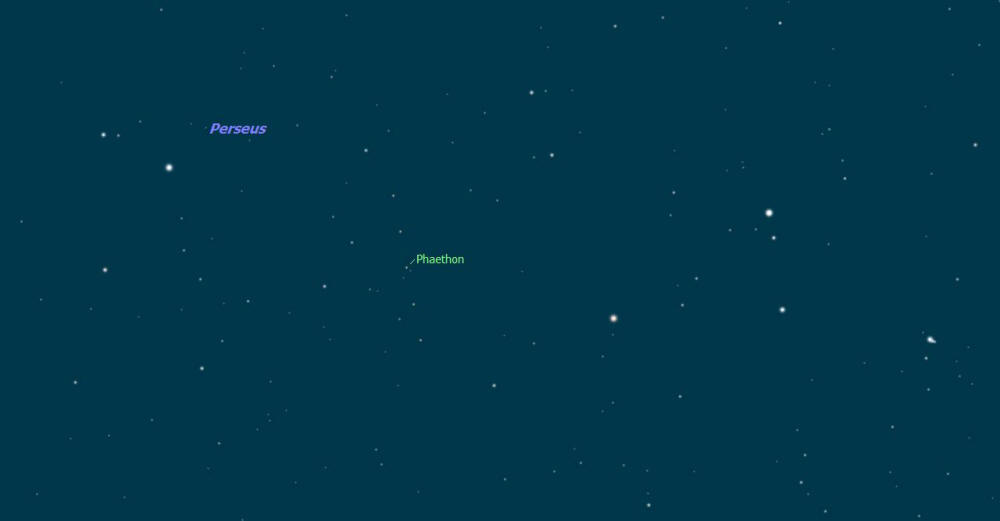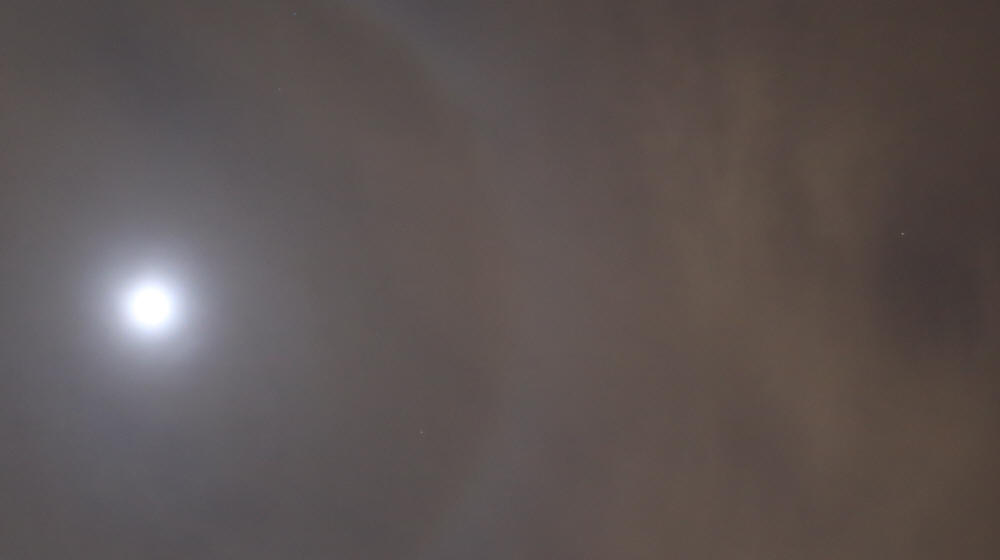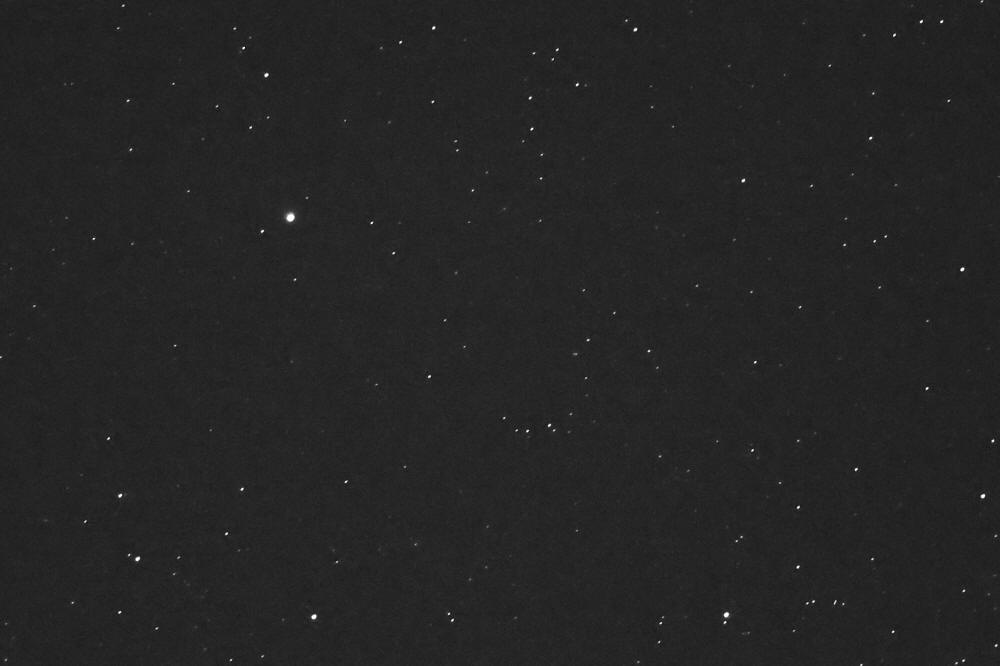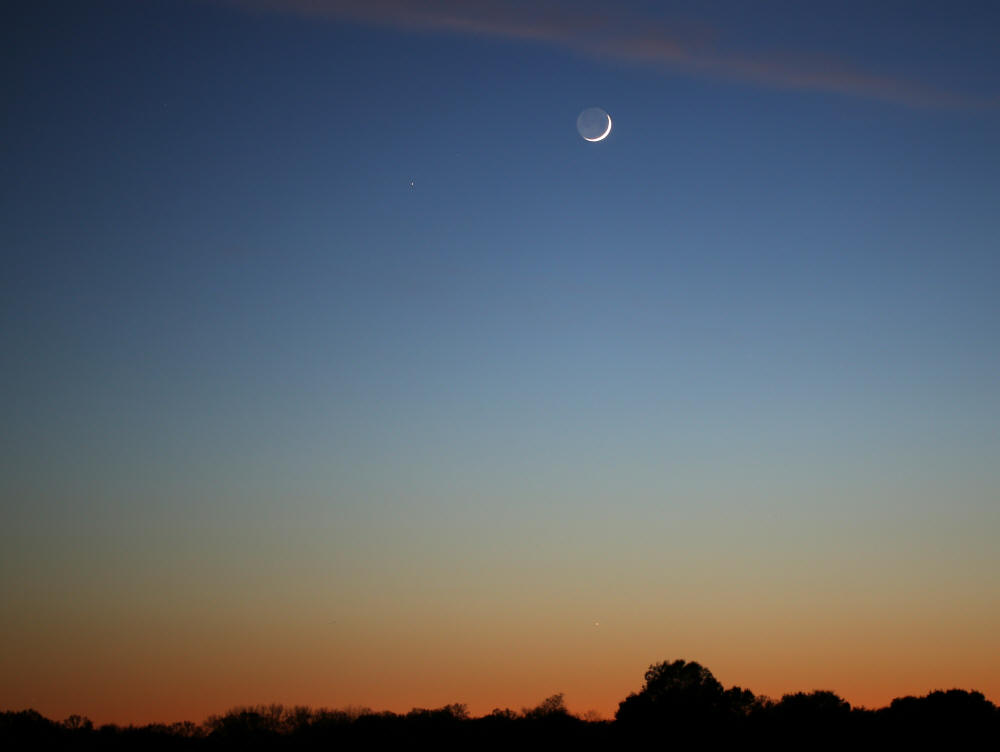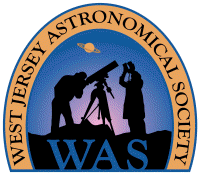Mercury and Antares
December
28, 2017
The planet Mercury was spotted on December 28, 2017, at Swede Run in Moorestown, NJ, at the start of a cold spell when the temperature hovered around 14°F. Mercury was initially seen with an unintentional glance of unaided eyes just above the tree tops at 5:55 am, when it was magnitude -0.2 and 3° altitude in the constellation Ophiuchus. A few minutes later, Antares, in the constellation Scorpius, was spotted 8.6° to the right of Mercury (at the 3:30 o'clock position), confirming the sighting. When I left at 6:30 am, Mercury was still easily visible with unaided eyes (sunrise would be at 7:19 am). The image above, looking southeast down Westfield Rd towards the traffic light at the intersection of Borton Landing Rd, was captured at 6:04 am EST with a Canon 6D digital SLR camera and a Canon 100 mm f/2.8L macro lens on a fixed tripod. Exposed 1 second at f/4, ISO 4000. It was cropped to about 75% of the original size for a field 15° wide x 10° high. Mouseover for labels. Note: The red light in the trees near the middle of the frame is an aircraft warning light atop an antenna at the Lockheed-Martin complex. Mercury was spotted again on the morning of January 1, 2018, from Swede Run, the old Mart site in Pennsauken, and finally my home in Maple Shade, NJ.
(4) Vesta, Jupiter and Mars
December
28, 2017
The asteroid, or minor planet, (4) Vesta was spotted with 15x56 binoculars on December 28, 2017, at Swede Run in Moorestown, NJ. The major planets Jupiter and Mars were also nearby, 4.4° apart in the constellation Libra (mouseover for labels). Jupiter was quite bright at magnitude -1.8, Mars verged on first magnitude at +1.5, and Vesta was well below visibility with unaided eyes at magnitude +7.9. However, when it reaches opposition on June 19, 2018, Vesta will be visible to the unaided eye at magnitude +5.3, with the caveat that it will be somewhat low in Sagittarius, about 30.5° altitude at transit. This picture was captured at 5:42 am EST with a Canon 6D digital SLR camera and a Canon 100 mm f/2.8L macro lens on a fixed tripod. Exposed 2 seconds at f/4, ISO 4000, in monochrome mode. It was cropped to about 78% of the original size for a field 16° wide x 8° high. (4) Vesta was spotted again on January 1, 2018, at 5:45 am from Swede Run with 15x56 binoculars. Jupiter and Mars were now 2.6° apart, and along with Zubenelgenubi, were a lovely sight together in the field of the 15x56s. They will be at conjunction on the evening of January 6, and from our area, will be 0.3° apart on the mornings of January 6 and 7, 2018.
(3200) Phaethon Observed
December
13, 2017
Since it was clear on the morning of December 13, 2017, I went to Swede Run in Moorestown, NJ, to see if any Geminid meteors would appear and to check out the location of the asteroid (3200) Phaethon, which is making a close pass by earth this week. I arrived around 2:15 am EST, and in the open field area, experienced the full effect of strong wind and temperatures in the low 20's °F. Using 15x56 binoculars, I quickly identified the star field to the left of Mirfak (Alpha Persei), in particular, the string of stars starting at Nu Persei and arching up and to the right as seen in the SkyTools clip above (mouseover for labels). A couple of asterisms above the peak of the arch that bracketed Phaethon were easily seen, but Phaethon itself at magnitude 10.8 was too dim for these handheld binoculars in suburban skies (albeit, darker than my home skies). I saw a faint meteor in the binoculars while looking at this area. It moved from the top to the bottom of the field, and it wasn't until a little later that I realized Gemini was nearly overhead, so this meteor probably did radiate from there. I then decided, despite the cold and wind, to get out my 85 mm spotting scope (continued below).
I had the 85 mm scope set up about 2:30 am EST, and at the minimum 27x, quickly found the asterisms flanking (3200) Phaethon. Mouseover to see the outlined asterisms in this SkyTools clip, which is about 1.5 degrees wide. I then increased the magnification to the 60x maximum and inspected the area between the those asterisms (marked with fainter blue lines). I had not included enough detail in my printed SkyTools chart to directly pinpoint Phaethon, so I made a mental note of the positions of the star grouping at the center (these charts, made afterwards, are not the same ones I used in the field). At 2:40 am, I surmised the object labeled Phaethon here was the one I wanted. However, I had to wait for some unmistakeable movement to occur before I could be sure. At 2:50 am, the movement was confirmed. At 2:40 am, Phaethon was almost directly above a field star, and 10 minutes later, it was closer to, and above-right of that field star as shown by the pale reddish overlay lines. At 2:40 am, Phaethon was at 44° altitude and 299° azimuth. The labeled track of Phaethon in this clip extends for 13'16", so during the 40 minute period between 2:20 and 3:00 am, it moved an average of 19.9 arc seconds/minute. Between 2:40 and 2:50 am, I also caught a faint Geminid in the east with unaided eyes. By 2:50 am, the crescent moon was visible at the tree tops to the east (it rose at 2:37 am).
22° Lunar Halo
December
7, 2017
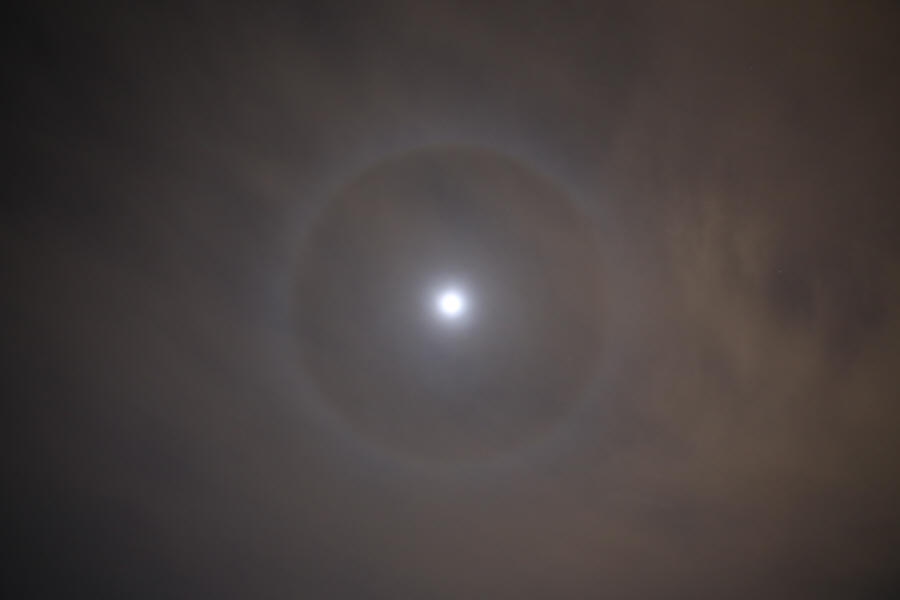
On the morning of December 7, 2017, I was putting out the trash late, and as always, I looked up at the sky, even though it was generally cloudy. However, the clouds weren't thick enough to block out the 81% illuminated waning gibbous moon, in Gemini at 66° altitude, about 3.7 days past full. As a bonus, the clouds generated a 22° radius halo, and perhaps a slight corona close to the moon. This picture of them was taken at 2:54 am EST with a Canon 6D digital SLR camera on a fixed tripod and an Irix 15 mm f/2.4 Firefly lens, which provides an uncropped field 100° wide x 77° high with the "full-frame" 6D as seen here (calculated trigonometrically). It was exposed 1.6 seconds at f/4, ISO 1600, with 3600K white balance. To show the halo, the moon itself is greatly overexposed, so the phase isn't visible. Besides size reduction for this web page, no processing was applied.
The image below is a 16:9 crop of the original (with no other adjustments besides size reduction). Procyon (Alpha CMi) is now visible 18.4° from the moon at the 4 o'clock position inside the halo, and outside the halo, Betelgeuse (Alpha Ori) is 40.3° from the moon at the 2:30 o'clock position. Mouseover for labels.
Ross 128 / FI Virginis
November
25, 2017
With clear skies on the morning of November 25, 2017, I went to Carranza Field in Wharton State Forest, NJ, for the primary purpose of spotting the star Ross 128 (FI Virginis) and/or capturing an image of it. This effort was prompted by a Bob King article at Sky & Telescope online suggesting readers should try to observe this star, which hosts an earth-sized exoplanet, Ross 128b, that's in the habitable zone of its host star and has recently been in the news. I succeeded on both counts. The image above was captured at 5:01 am EST (18 minutes before the start of astronomical twilight) with a Canon 6D digital SLR camera and a Canon 200 mm f/2.8L telephoto lens on a fixed tripod. It was exposed 2 seconds at f/2.8, ISO 12,800 in monochrome mode. It was cropped to about 34% of the original size, yielding a field nominally 3.5° wide x 2.3° high. Mouseover for labels.
Then, using the image on the camera's viewing screen as a guide to the star field near Zavijah (or Zavijava, Beta Virginis), augmenting my SkyTools and AAVSO finder charts, I found Ross 128 visually at 5:20 am with my 85 mm spotting scope at 60x, 1.2° from Zavijah. It was dim, but not that difficult to see. No reddish color was noticed (probably need a bigger scope for that). Rather than star hopping from Zavijah, the "mini-Scorpius" asterism near Zavijah drew my attention at 27x, then I zoomed to 60x to get a solid view of Ross 128, which was in the "Dschubba (Delta Scorpii)" position of the asterism. According to the Telescope Calculator at Sky & Telescope online, an 85 mm scope can reach magnitude +11.4 at 27x and +12.3 at 60x under clear dark skies. Consequently, the four stars in a diagonal row labeled with magnitudes (including Ross 128) were unambiguously seen.
Mercury, Saturn and the Crescent Moon
November
20, 2017
On November 20, 2017, the 2.45-day-old, 5.5% illuminated, waxing Crescent Moon was grouped with the planets Mercury and Saturn in evening twilight. This picture of them was captured from Swede Run in Moorestown, NJ, at 5:27 pm EST, 47 minutes after sunset at 4:40 pm EST, when the moon was at 10.0° altitude, Saturn was at 9.1° altitude and Mercury was at 2.7° altitude (mouseover for labels). At the time, Mercury was at magnitude -0.34 and Saturn was at magnitude +0.53, so Mercury was 2.2x brighter than Saturn, but more difficult to see because of its lower altitude, which means it suffered greater atmospheric absorption and had a brighter twilight background. This is the third sighting of the sixth (and final) elongation for 2017. Taken with a Canon 6D digital SLR camera and a Canon 100 mm f/2.8L macro lens on a fixed tripod, then lightly cropped producing a field about 15° wide x 11° high. Exposed 1/4 second at f/2.8, ISO 400, daylight white balance.
Click here for the previous page.
Click here for an index to previous SJAstro pages.
